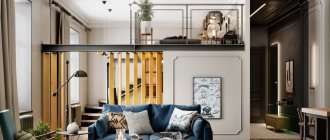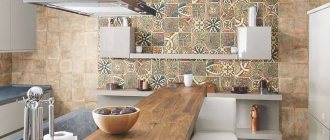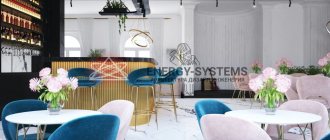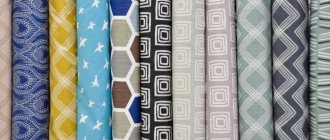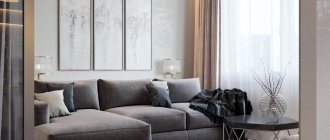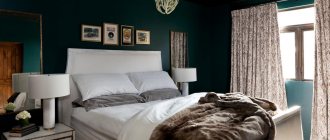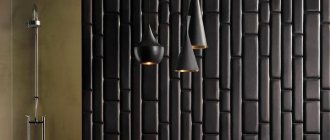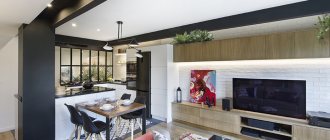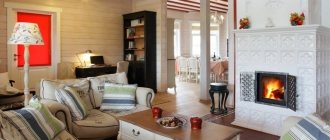What it is
Ceramic tiles have been used for cladding all types of floors for a long time, but the variety of various shapes, as well as patterns, has never been particularly observed.
Such flooring was previously intended solely for the practicality and durability of the floor. Today, it should attract special attention from guests in the home, decorating the design. This is why many buyers previously did not choose floor tiles to decorate their home
Patchwork is a unique technique with unusual patterns combined in one fabric. It originated from sewing patches of various shapes, all kinds of colors and images.
How to combine
Tiles in the kitchen 45 elegant and functional floor finishing options
There will be no major mistakes when matching the pattern, each ceramic tile has a unique pattern. It is not at all necessary to buy ready-made kits in the store. You can easily assemble them yourself, based on your taste. As a result, you will get a unique flooring design.
If you decide to make tiled patchwork yourself, you need to take into account the main aspects in this matter. Tiles should always be used in only one format; calibration is necessary. It must have identical edges, thickness and surface type. This is one of the main rules for a successful purchase and high-quality cladding.
In addition to geometric similarity, the tiles should have one more common feature - the same color. They should echo each other with similar shades. This is how they create all kinds of color combinations that look easy and stylish. It is worth remembering that too much colorfulness quickly tires and irritates over time.
Kinds
The best ideas for rational organization of free space in the kitchen
There are several techniques of this type when decorating rooms. If you decide to use this one of them, then you need to decide on the type.
Patchwork is divided into the following categories:
- Chic is a professional finish that resembles the texture of natural wood.
- Colea is a technique used for the bathroom.
- Vives is a technique that looks better in a standard kitchen interior and can be used in any room in your home.
- Vodevil is a technique that is famous for its complex patterns.
This is only a subjective division into categories, because there are many more patchwork techniques; there are no restrictions in this technology. This technique is also used for paving slabs. Today, such tiles are used in many areas of construction.
If you have previously covered a floor with multi-colored floor tiles of the same size, laying out different compositions from colorful tile fragments, then you are already familiar with the patchwork technique. This is a kind of mosaic of identical tiles, through which a certain ornament is laid out.
Kitchen design tips
Living room in Provence style
Decorating a kitchen in a “patchwork style” is a new, fashionable trend. It allows you to use original, non-standard solutions in its design. But here, as in everything, it is necessary to observe moderation. Here are some tips to help you correctly use patchwork tiles to create your kitchen interior:
When decorating a kitchen interior, patchwork tiles with bright floral patterns or geometric patterns against a background of plain coffee or beige tiles are best suited. The furniture in the kitchen should be made in a laconic and simple style. The colors of the tiles should be combined with the shades of furniture and kitchen accessories, which, in turn, should not be full of bright colors. A black and white stylization of the room with individual color accents of “patchwork” tiles looks ideal. They enliven the interior and give the room a special play of color. The kitchen interior should not be “overloaded” with decor. If the kitchen is large and spacious, then it is better to use patchwork in soft colors for the floor. Floor tiles in pastel colors are an ideal interior option, provided that furniture in warm, autumn colors is used. In a small kitchen it is better to use bright and small elements. Don’t cover the entire floor in a small kitchen with patchwork porcelain tiles - make a small “mat” of tiles in the right place - it will fit perfectly into the interior of the room. To create a harmonious atmosphere, it is advisable to arrange a kitchen apron from patterned tiles. It will decorate the room, make it elegant and festive. When using it, you can stylize the kitchen in the spirit of minimalism - abandon various decorations, facades with large handles, and bright interior elements.
When decorating a kitchen apron, the main part of the design should be placed in the center, at eye level, and small details should be placed at the edges. When alternating patchwork tiles, it is recommended to use products from the same manufacturer
If you need to create a composition from tiles of different brands, then you should pay attention to the color and texture of the material. When laying tiles on walls and floors, you must use the same pattern on their surfaces. A truly win-win option for kitchen design is the selection of tiles that imitate natural materials. It looks noble and does not “muffle” the beauty of the furniture.
The use of decorative tiles and porcelain tiles in a patchwork style can significantly embellish the interior of a room. Make it bright, unforgettable and original. A large selection of colors and patterns will allow you to independently or with the help of a designer assemble a whole composition from individual “shreds”, bring any design fantasy to life, and stylize the room in the right way
The only thing to remember is that patchwork tiles should not attract attention, but only complement the interior
Patchwork style bathroom: design canons
Could the needlewomen who found a use for pieces of fabric imagine that their idea and execution technology would become a sophistication in interior design? Until recently, colorful textile products were found only in the form of bedspreads, carpets, upholstery on ottomans, covers on chairs, and decorative pillows. These were integral details of the furnishings of bedrooms, living rooms and kitchens, reflecting the aesthetics of shabby chic, Provence, and pop art. Having moved to the room for bathing and washing, patchwork decor can solo in different images:
- finishing the floor with ceramic carpet;
- lining an accent wall with a decorative tile panel;
- design of arches, door or window slopes;
- decorative inserts above the mirror or around the round font;
- decorations on the outside or inside of the sink;
- covering the steps of the stairs leading to the hydromassage bathtub or shower compartment located on the podium;
- design of the screen under the font;
- chaotically scattered decoration elements throughout the room.
Bathroom decoration in patchwork style
A patchwork style bathroom welcomes the masterly use of various modifications of ceramic facing materials: tiles, mosaics, porcelain tiles, panels. Depending on the area of the room, you should select the optimal size of finishing elements:
- From 10 to 25 cm for decorating small rooms. Small cladding details, arranged in narrow rows, diffuse the view and create the effect of perspective. This draws attention away from the cramped confines of a miniature bathroom. To facilitate finishing, it is recommended to use block mosaic compositions.
- From 25 to 45 cm for decorating walls in spacious rooms. Here you can easily try on different images of patchwork tiles in the bathroom: completely tile one of the walls, arrange fragments on perpendicular planes.
- Slabs with a size of 45 cm or more look organic on the floor, without overloading the eye with voluminous outlines with dynamic colors.
The size of the finishing elements is selected based on the area of the bathroom
When choosing a design for a patchwork mosaic or tile, you need to take into account the visual perception of multi-colored decor. For small bathrooms, it is appropriate to use models with monochrome colors, colorful, but finely-component patterns and ornaments. The design of rooms with a large square area is freedom for the decorator’s imagination. Even multi-colored cladding is perceived easily and delightfully, like an abstract painting.
How to choose a color scheme for the kitchen
Patchwork can also be islands like this.
For patchwork, the choice of color is important. Initially, it seems as if the purpose of creating a certain stylish element was to pile up bright colors in the room. If in the patchwork style bright colors are correctly combined with plain colors, for example white, then even skeptics will notice the attractiveness and irresistible, fabulous ornament that imparts beauty and comfort to the interior.
The most unexpected options can be combined
Typically, patchwork to decorate the style of the kitchen is used in calm white, warm autumn shades. To create a seasoned interior, you should add to it a kitchen set with scuffs in an antique style. To create an idea for a stylish solution, you can use one of the noblest and most commonly used colors in patchwork - reddish brown. Its shades can also be used in surrounding furniture, but the kitchen apron will look most presentable in this solution.
Patchwork in one color scheme is very common
You can make an apron in a patchwork style in a contrasting version. The color scheme of the walls in the apron area can be done not only in bright shades, but also in the color of natural linen, burlap, and unbleached wool. Such an apron will look great if you make the rest of the space close to the shade of milk; you can complement the interior with the same handmade chair covers with your own hands.
Or it can be so, the main thing is that bright notes do not dominate
Patchwork, made in the postmodern style, is the newest and most unusual option, which is created by an amateur. If the owners of the room decide to make an apron in this direction, then the type of cladding, in addition to patchwork, should combine classic modern and pastoral styles. Daguerreotypes would be an excellent addition. This cocktail reflects the fashion trends of the 19th and 20th centuries, but at that time such a mixture was impossible.
Here's a patchwork in a modern kitchen
But this is a beautiful, seemingly handmade patchwork
An apron with patchwork elements will fit into any interior
Browse the patchwork style collections from ceramic tile manufacturers Kerama Marazzi:
Patchwork style bathroom design variations
Inimitable images of patchwork fabric can take their rightful place in the interior of a bathing room, interpreting diverse stylistic concepts:
- It is reasonable to brighten up the excessive simplicity of country music with colorful mosaic decor made up of tiles with a neutral background (white or sky) and natural colors of ornaments - yellow, red, green;
- the antiquity of the furnishings in a retro or vintage style will be emphasized by tiled panels with faded dull colors, imitations of microcracks, abrasions, uneven edges, chips, a design similar to ancient majolica with hand-made artistic painting;
Aged tiles look impressive in the interior
- It is important to paint the prevailing whiteness of the Scandinavian interior with rich tones, like multi-colored gouache spilled on a snow-white sheet of paper;
Patchwork tiles add personality to a Scandinavian-style bathroom
- It is appropriate to limit the chaotic decoration in the boho genre to a fragment on an accent wall, floor, or use it to decorate the countertop in the wash area.
Wall decor in the wash area with patchwork tiles
In order not to create the effect of excessive colorful clumsiness, you need to partially use parts with a patchwork design in the bathroom. Photos of combinations of patchwork tile decor with multi-colored shower curtains, rugs, stained glass windows on the lampshade of a ceiling lamp, glass windows or doors are a source of inspiration and selection of the optimal design solution for the interior.
A patchwork style bathroom is distinguished by originality, inexplicable ideas of decorators, and an artistic basis using the entire color palette. Interior design with a predominance of bright colors creates a festive atmosphere, motivating to take a bath or shower in a joyful environment with an abundance of rainbow-designed interior elements.
Patchwork style bathroom is original
Patchwork decor delights with its variegated colors, fascinates with the originality of its ornaments, and provokes you to touch with your hands unusually executed compositions, as if sewn from ceramic or stone scraps. Thanks to its unsurpassed visual effect, patchwork is always very popular, regardless of the trends of changing interior fashion.
Patchwork tiles for the kitchen room
The patchwork technique combines colors and textures and was first known as a textile technique. But still, this elegant, skillful form is becoming popular in other areas.
Patchwork tiles take on this colored pattern. This approach has almost no thematic boundaries - since this style is suitable for both ultra-modern design and strict classics. Likewise, such an element connects different purposes, thanks to which it contains the specifics of an eclectic style.
Patchwork tiles in the interior - photo examples of kitchen arrangement
Patchwork panels can be used to decorate kitchen walls to replace paintings, paintings and aesthetics. A colorful “mix” of patchwork styles and patterns can be placed just on part of the wall or cover it entirely. Patterned patchwork tiles are considered an interesting alternative, which is better suited as a contrast with simple furniture and smooth facades of kitchen furniture.
For finishing work, we can use ready-made collections or try to create our own compositions by selecting tiles of the same format and laying them in random order. Likewise, laying tiles in a patchwork style becomes a natural art that you can perform personally, implementing your own creative concepts. In this case, you should coordinate the pattern with the interior style and key colors that dominate the room.
A background made of patchwork tiles will aesthetically highlight the structure of wooden facades.
By choosing this tile option, you can rely on minimalism in your kitchen design. In the same way, we will achieve a subtle effect without a feeling of satiety. You can refuse other decorations, for example, facades with large handles or an abundance of other patterned or light-colored components.
Patchwork tiles for kitchen backsplash
The apron above the kitchen countertop is a fairly representative free space. More and more attention is being paid to its cladding. Not only for practical reasons, but also because of aesthetic value, materials are selected for it in today's kitchens. Patchwork tiles are considered an exemplary motif to balance these two aspects. This is a conservative method to present the avant-garde in the interior. Despite the fact that this area is small, it is located in an open, clearly visible place - this is an excellent solution.
The ambience of the kitchen with geometric and floral motifs in bright colors can be applied with all other tiles. Such a combination of patterned and monochrome tiles will create an attractive effect that will become inimitable.
Patchwork floor tiles on the kitchen floor
Ceramic flooring is considered a traditional material, which is characterized by unsurpassed comfort. But still, this practical floor decoration does not have to be uninteresting.
Nowadays there are many attractive flooring options, such as wood-look tiles for the kitchen or honeycomb tiles, but patchwork is an equally good option. This can be patchwork tiles in pleasant colors or bold light colors.
Photo. Honeycomb floor tiles in patchwork style for kitchen floor
For adventurous interiors, you can try to create a real riot of colors on the floor. Moreover, such a strong accent can be used in a minimalist interior.
Patchwork tiles for walls and floors
Variations of this style show that even patchwork tiles don't always have to be associated with glamour. You just have to follow a few rules, and complex arrangements will have their own charm. When laying this tile on the walls and on the floor or on the apron and walls, you need to use the same pattern on two surfaces.
The key theme on various surfaces should be harmony. The color of other elements in your room should be repeated in the cladding using tiles, then the harmony will be very complete. “Patchwork” tiles look very nice in a black and white room interior in combination with other cladding elements in white and black. Some colorful accents will give the room a play of color and enliven the interior.
A well-thought-out interior design must be perfectly coordinated with all components and the dimensions of the room. With patterned tiles you can easily “achieve” a negative effect that will dazzle your eyes, so if you have a small room, it is better to make clear and small accents.
Patchwork tiles in the interior: choosing style and color
When selecting the design of the slabs, it is necessary to take into account the style of the room. With proper combination of different colors, patchwork blocks can be used in any area of interior design.
Decorative tiles allow you to create an original accent in a monochrome interior when decorated in a minimalist style. It is allowed to use ornaments in black and white, a combination of gray and white, beige and blue. However, the use of no more than 1-2 combinations of shades is allowed, which should resonate with the color scheme of the room. The decoration is exquisite with a pattern that repeats the main motifs of the room’s decor.
When choosing a country style, slabs with patchwork patterns in brown, terracotta and sand tones are used to decorate the room. It is optimal to use a multi-color ornament, use bright colors while respecting the proportions of the room and using plain furniture in beige, gray or brown.
Slabs with laconic ornaments can be an interesting addition to a classic-style interior. For this purpose, continuous flooring is not recommended; it is possible to create accents in the bathroom, in the kitchen next to the work area, or in the shower room.
Patchwork ceramics are recommended for inclusion in the decoration of rooms in vintage and retro styles. The surfaces of the slabs can have bright floral patterns, worn surfaces, stylized as aged.
The original technique is used when implementing a design project in the Dutch or Scandinavian style. The best decoration is ceramics with patterns in blue and white tones. Shades will create a comfortable, light atmosphere and visually expand the room.
In the Provencal, Mediterranean, and classic styles, slabs with patterns in pastel colors are used and emphasized with rich brown shades, terracotta, muted green, and gray colors.
Slabs with ornaments will make an accent when partially finishing the floor in rooms in fusion, French, Art Deco, Art Nouveau, and vintage styles.
Beautiful options
Finishing the floor with this technique is a common option for using tiles. The material may differ in size and surface texture. More often it is glossy, although recently a matte variety has appeared on store shelves.
If we consider in detail the variations in the decor of floor tiles, we can distinguish the following types of ceramic products:
- imitation of other materials (for example, wood or stone);
- abstract patterns on tiles;
- monolithic tiles with a special texture.
- bright rich colors.
Today the trend is tiles with all kinds of patterns. It can be purchased from Russian manufacturers or foreign brands.
For example, we can highlight the company Cicogres (Spain), whose products are quite popular. The Spanish manufacturer has been maintaining the brand for several years and takes pride of place in the construction floor ceramics market. The manufacturer produces various designer products that combine bright colors and unique stylish patterns. With all this, the tones remain quite simple and are emphasized by contrast.
Shades can be selected according to the interior of the room. If you choose yellow floor tiles, you can experiment and buy green wallpaper. It will be unusual, but quite stylish and fresh. Maximize your design skills and creativity. If you need to support the color scheme of the interior, you should choose the material in such a way that one or two shades match.
Principles of patchwork technique
Since patchwork has spread to the masses by leaps and bounds, it would not be amiss to mention the main nuances of the work.
- To make the artistic space of the room seem unified, you need to skillfully combine drawings. It is worth remembering that the tiles must match in color, be of a single format, and their patterns and designs must resonate with the overall design of the room;
- It is customary to place the largest drawings and panels in the center of the composition, at eye level, and small ones - at the edges;
- If you finish only with patterned tiles, they will be annoying, so you need to combine them with plain ones: the approximate ratio is 30% textured, 70% smooth;
- Patchwork can be monochrome, multi-colored and even 3D. The surface of ceramics can be smooth and textured, matte and glazed - all these factors must be taken into account when combining;
- It is best to buy tiles from the same manufacturer: the material should be the same not only in width and length, but also in thickness, type of edge and method of surface treatment;
- Floral patterns are most common, geometric shapes and abstractions are less common. Depending on the purpose of the room and the style of the interior, the pattern is selected.
Interesting solutions in the interior
The most popular choice is a two or three color mix; a multi-color “bedspread” is not suitable for every room. Blue-white, black-and-white and chocolate-beige variations are popular. However, bright canvases also look very interesting.
A contrasting combination is patchwork-style tiles with imitations of natural materials. Tiles that imitate a wooden, concrete or stone surface will highlight the excessive diversity and look very noble. It is a kind of background, the main thing is to choose the appropriate shade: cream, steel-gray, white, and coffee colors are popular.
The patchwork itself is quite self-sufficient, but be prepared for the fact that such a mosaic floor will outshine all other objects in the room and will invariably attract attention only to its own person. For such a room, you should choose monochromatic furniture, but prints on curtains or pillows are quite appropriate - they should echo the patterns on the floor or walls
If you choose patchwork tiles to decorate an accent wall, you can afford to experiment boldly not only with colors, but also with sizes. In the collections you can find not only square or rectangular tiles, but also hexagonal or oval ones - it’s time to get creative!
There should be only one accent wall in the room, otherwise the room will be overloaded with textures and patterns and it will simply be uncomfortable to be in it.
Fragmentary decoration also looks good: individual elements such as niches, steps, columns, surfaces above the fireplace enliven the room and give it a special coziness.
In small rooms, small motley tiles will be appropriate; a large panel will visually make the wall smaller. Other finishing elements should be painted in calm shades. For large rooms, it is quite possible to choose catchy textures and massive patterns; with the help of “patchwork” tiles, you can place accents and zone the room. If there are not many patterned tiles, choose contrasting colors - pastel and bright.
For the kitchen, floral or geometric patterns are often chosen and combined with plain tiles. The so-called “Gzhel” (white and blue tiles with painting) looks good. By the way, you can decorate not only a kitchen apron in a patchwork style, but also shelves, niches, a bar counter, and an accent wall above the table.
In the living room and dining room, the floor is often decorated using patchwork techniques. You can place a large panel in the center of the room - instead of a classic carpet, you can make small inserts, and if desired, make the entire surface colorful and catchy.
Such tiles are also appropriate in the bathroom, hallway, and loggia. It must be selected taking into account the overall style of the room. For example, for a vintage style, delicate, seemingly faded designs are appropriate. Provence also requires calm pastel colors, but bright mixes will also look organic in country style. Monochrome combinations of Dutch ceramics and Gzhel will suit the Mediterranean and classical styles; Moroccan and Oriental styles are characterized by rich shades and a large number of patterns. For a modern room, it is better to choose monochrome compositions.
Collections of tiles in the patchwork style are represented by many manufacturers: Chik from Cicorges, Patchwork from Almera Ceramica, Roivoli, Aranjuez and Vodevil from Vives, Patchwork from Realonda, Mainzu from Rialto, Country&Masia from Equipe, Saint Tropez from APE and others.
Patchwork style tiles are a bold, but certainly successful solution that can transform even the most boring and dull interior!
- Carpet tiles.
- Ceramic tiles in oriental style.
Floor mosaic
In the hallway, living room and other rooms, patchwork-style tiles can occupy the entire floor space or be located in a narrow long strip. Compositions with ornaments in the form of small insert fragments are popular. For bathrooms, loggias, verandas, and toilets, patterns are often selected in the form of a carpet located near the sofa, benches or in the central area of the rooms.
To properly accent the working areas of the room with mosaics using patchwork technology, it is better to contact an experienced designer.
How to decorate the interior
This technique is used by many designers for modern and ethnic design trends. Mostly it is Provence, country and similar styles. For her, the main colors are white or gray tones.
In the interior of any room in the house, patchwork ceramics will be the main source of expressiveness and mood. This way you can refresh your interior and add brightness to it. Your room will become special and unique.
If the home is made in monochrome colors, you can use tiles that have two colors. Also, quite often, designers use the technique of difference, when the tiles differ in ornamentation, and not just color. Country music is closer to this theme than other genres. It also has many patchwork patterns in the interior elements.
Patchwork in blue and white tones looks quite gentle and relaxed. The airy structure of floor tiles gives your interior a special elegance. Cladding in this style will look advantageous in classic interiors. Please keep this in mind when purchasing. The use of a tiled combination of patterns will look beneficial in vintage interiors.
Many people may think that this technique can be used in any style, but some basic principles must be observed.
For small rooms, you must follow the basic rules:
- the interior should have a minimum of decor;
- the furniture in the room should not be too bright, the upholstery print is undesirable;
- The size of the drawing must be selected taking into account the available area.
For a small room, it is harmonious to use a patchwork-style flooring. Today it is quite popular. For the overall composition, you can use bright colors in small quantities, even if this is not typical for you. This will help add a bright accent to a boring interior.
Pay attention to the style: such tiles are not appropriate in every direction. If the area of the room is small, you can beat the lack of space using zoning techniques
Such tiles can be combined with a plain one, or you can lay out a small canvas from colorful fragments, framing its edges with an original border.
Do not overdo it with dark and cold tones when choosing multi-colored material. This way you can visually hide the degree of lighting in the room. Do not use a huge number of shades in the decoration: they will look more harmonious if there are no more than 4 - 5. It is advisable that the design have monochromatic inserts: this way it will look more interesting.
To learn how to choose a tile, watch the following video.
Using patchwork technique in the interior
The “ancestor” of patchwork is the country style, in which patchwork mosaic will look as organic as possible. The theme will also include a spectacular white and blue combination (like Russian Gzhel or Dutch ceramics). This wall cladding looks airy and will undoubtedly decorate the room, adding light and space. Also, a similar design is appropriate in the Mediterranean, classic style and Provence interior.
“Patchwork quilts” on the walls will enliven the room, adding brightness and mood to it. Calm two-color tiles, repeating the main palette of shades used in the room, are also suitable. To highlight the retro interior, you should choose monochrome patchwork ceramics with the effect of a faded ornament. Interestingly, there are also patchwork options made of smalt (colored glass) that have a 3D effect.
Kitchen interior in patchwork style
If you want to “lift the mood” in your kitchen and surprise guests with an unusual interior “not like everyone else’s”, feel free to decide to decorate the walls or floor of the kitchen in a patchwork style. A panel of multi-colored tiles will fit perfectly into a “wooden” kitchen, adding coziness to the interior. At the same time, patchwork is an attribute not only of “rustic” styles, but can also decorate even a modern high-tech kitchen or loft interior.
For kitchens in white, the decorative technique of patchwork is simply a real find. The Scandinavian style in the interior can be complemented with decorative tiles in white and blue tones. Bright masonry can serve as a kitchen apron, and if you want to add a “zest” to the room, use voluminous tiles that have a textured feel. You can also decorate a bar counter or another partition zoning the kitchen with patchwork tiles.
An interesting technique is to create an accent on one of the walls, the main thing is that the remaining elements are of a restrained design.
Patchwork looks unusual but advantageous in combination with other natural finishing materials, such as parquet.
Options for decorating a bathroom using patchwork tiles
Decorative patchwork coverings are always very elegant, so a bathroom and toilet decorated with such tiles will turn out to be very unusual. There are several tips on how to fit patchwork into the interior of a bathroom:
Use inserts in the form of randomly located elements of patchwork ceramics on the wall, while the ornament and color may vary, the main thing is to maintain the overall style of the room.
You can focus on a specific object, such as a sink. In this case, the furniture should be neutral in color: white, beige, light blue or gray.
A pattern in the form of a narrow stripe on the wall will visually increase the area of the bathroom. Also an effective design technique would be to lay a patchwork pattern on the floor with an imitation of a rug.
Types of patchwork tiles
Modern manufacturers of ceramic tiles offer ready-made collections of various patterns, in various colors, which can be freely combined when decorating the interior. The variety of designs and their colors is amazing. These can be geometric patterns or floral prints, or a combination of both. The most popular types of patchwork tiles:
- neutral black and white or blue and white and their shades;
- multi-colored patchworks;
- modern three-dimensional 3D patchworks.
Laconic patchwork in black and white.
All types of patchworks come with a plain background tile.
The sizes of tiles can be very different - from small square to large rectangular. The tile can also be hexagonal. Multi-colored patchworks can be bright or matte. The design is not necessarily geometric or floral. It can be an imitation of natural wood or stone. The uniqueness of the kitchen interior can be created with the help of individual designer painting of tiles with special paint for porcelain. White clay tiles produce the effect of a mirror surface, which looks great next to tiles that imitate a concrete or stone surface. Blue and white tiles reminiscent of the famous Gzhel will add special elegance and sophistication to the kitchen.
With the help of patchwork, you can create a real artistic panel, boldly combining colors and patterns. This process is complex and painstaking, requiring impeccable artistic taste. Therefore, we advise you to first consult with a professional designer or familiarize yourself with examples of patchwork tile design presented on the Internet and in specialized literature. And as a result, your efforts will be rewarded with a unique interior that will please the eye.
Stylish kitchen decoration.
The beauty of patchwork is the absence of strict rules, which allows you to realize any aesthetic fantasy. Modern patchworks are a real find for designers, as they can decorate and elevate any modern interior.
Patchwork style
A ceramic backsplash in patchwork style attracts attention at first sight
Patchwork in the interior is formed according to the mosaic principle. Multi-colored modules are laid out in a certain order. A patchwork picture is being assembled. This technique does not provide for a single application, but the creation of at least several bright areas in one room. The exception is small areas where the style is used, in particular, the creation of a kitchen apron. This kitchen will perfectly diversify a monochromatic interior. Read about Scandinavian-style kitchen design at this link.
And this is what the patchwork on the floor will look like
In some cases, owners decide to use the patchwork technique when they have several types of tile modules of the same size left. This design direction allows you to combine elements in different color schemes, sometimes with different shade intensities, since the whole picture is assessed “by eye”.
Advantages and disadvantages
Advantages:
- the possibility of independently assembling a design composition;
- tiles can be composed of colored modules, different collections that differ in style;
- freedom in choice and combination of colors is provided. There are no restrictions in patchwork style;
- there are many manufacturers selling special tile or mosaic sets designed in patchwork style;
- an original solution is created that will fit perfectly into both the interior of traditional English and marine design.
Flaws:
- it is difficult to choose the appropriate combination of tiles, especially if the surrounding background is not uniform;
- difficulties in combining patchwork with other bright and original styles;
- a bright background is created, it is almost impossible to overshadow it with any accessories. The only exceptions are patterns in pastel shades;
Features of use
Patchwork designs are printed on tiles of different sizes (from mosaics to large-format porcelain tiles). It has found application both in a small apartment and for the decoration of elite bars and restaurants. Patchwork in the kitchen emphasizes the style:
- country;
- Provence;
- Scandinavian;
- Mediterranean;
- shabby chic;
- boho.
Bright ethnic patterns dilute the cold and emotionally restrained high-tech, decorate any laconic interior, and create a peaceful rustic style.
The following features should be taken into account:
- patchwork is difficult to combine with a bright and heterogeneous background;
- You shouldn’t select all the walls and floor, because... excessive variegation tires the eyes;
- multi-colored patterns should complement the interior, and not dominate.
Popular Applications
Patchwork ceramic tiles are successfully used in many modern interiors. If the color of the other elements used in the interior of the room is combined with the tiled finish, then the patterned tiles will harmoniously fit into the design. But most often, “patchwork” technology is used for the following purposes:
- Kitchen and bathroom wall cladding;
- Design of columns, individual interior elements;
- Kitchen and bathroom flooring;
- Decorative covering for loggia, balcony, veranda, dining room;
- Apron installations for the kitchen.
The use of the “patchwork style” in these rooms is carried out both by completely covering the walls or floor with patchwork tiles, and by including it in certain areas - to decorate or highlight the object. After all, the edges of the numerous patterns of this tile are drawn in such a way that it can be used with all decorative elements.
The design of functional areas of the bathroom with patchwork tiles looks very original. In this case, the tile forms a separate element of the interior and emphasizes the space of the shower corner or wash area.
The ability of ceramic “shreds” to make a space brighter and to highlight it correctly determines the widespread use of patchwork tiles when styling small spaces: balconies, verandas, loggias. This also explains the frequent use of this decorative covering on staircase steps, when highlighting individual interior items and columns.
But let’s look at decorating a kitchen in a “patchwork” style in more detail. Let's give some practical tips on how to properly “patchwork” your kitchen space.
Application options
Patterned patchwork tiles are used in all the same places where regular tiles are used - these are bathrooms and toilets, kitchen splashbacks, flooring in the kitchen, hallway, balcony, and entrance area.
As a rule, “patchwork rugs” are laid on the floor of such tiles; a similar solution can be found in the kitchen and bathroom. This makes it possible to highlight one or another functional area, for example, a dining area in the kitchen, a shower area in the bathroom or an entrance area in the hallway.
It is appropriate to place a patchwork-style tile panel on the wall - it will become the main decorative accent of the living room, or highlight the dining area.
Patterned patchwork goes perfectly with regular, smooth and plain tiles. By combining them, you can avoid excessive diversity in the interior. Please note that patchwork is an active and bright pattern; if there is too much of it, it will attract all the attention and can break the geometry of the room. A large number of such patterns begins to dazzle the eyes, so they need to be used in very measured doses.
Source
